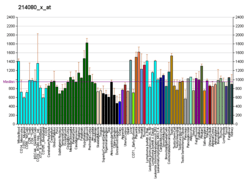PRKCSH
Glucosidase 2 subunit beta is an enzyme that in humans is encoded by the PRKCSH gene.[5]
This gene encodes the beta-subunit of glucosidase II, an N-linked glycan-processing enzyme in the endoplasmic reticulum (ER). This protein is an acidic phospho-protein known to be a substrate for protein kinase C. Mutations in this gene have been associated with the autosomal dominant polycystic liver disease (PCLD). Alternatively spliced transcript variants encoding distinct isoforms have been observed.[5]
References
Further reading
- Thornalley PJ (1999). "Cell activation by glycated proteins. AGE receptors, receptor recognition factors and functional classification of AGEs". Cell. Mol. Biol. (Noisy-le-grand). 44 (7): 1013–23. PMID 9846883.
- Lukàcs A (1978). "[Debate on prophylaxis]". Prevenzione stomatologica. 1 (2): 43–7. PMID 1076483.
- Hirai M, Shimizu N (1990). "Purification of two distinct proteins of approximate Mr 80,000 from human epithelial cells and identification as proper substrates for protein kinase C". Biochem. J. 270 (3): 583–9. PMC 1131772. PMID 2241894.
- Sakai K, Hirai M, Minoshima S, et al. (1989). "Isolation of cDNAs encoding a substrate for protein kinase C: nucleotide sequence and chromosomal mapping of the gene for a human 80K protein". Genomics. 5 (2): 309–15. doi:10.1016/0888-7543(89)90063-3. PMID 2793184.
- Maruyama K, Sugano S (1994). "Oligo-capping: a simple method to replace the cap structure of eukaryotic mRNAs with oligoribonucleotides". Gene. 138 (1–2): 171–4. doi:10.1016/0378-1119(94)90802-8. PMID 8125298.
- Gress TM, Müller-Pillasch F, Geng M, et al. (1996). "A pancreatic cancer-specific expression profile". Oncogene. 13 (8): 1819–30. PMID 8895530.
- Trombetta ES, Simons JF, Helenius A (1996). "Endoplasmic reticulum glucosidase II is composed of a catalytic subunit, conserved from yeast to mammals, and a tightly bound noncatalytic HDEL-containing subunit". J. Biol. Chem. 271 (44): 27509–16. doi:10.1074/jbc.271.44.27509. PMID 8910335.
- Ophoff RA, Terwindt GM, Vergouwe MN, et al. (1997). "A 3-Mb region for the familial hemiplegic migraine locus on 19p13.1-p13.2: exclusion of PRKCSH as a candidate gene. Dutch Migraine Genetic Research Group". Eur. J. Hum. Genet. 4 (6): 321–8. PMID 9043864.
- Arendt CW, Ostergaard HL (1997). "Identification of the CD45-associated 116-kDa and 80-kDa proteins as the alpha- and beta-subunits of alpha-glucosidase II". J. Biol. Chem. 272 (20): 13117–25. doi:10.1074/jbc.272.20.13117. PMID 9148925.
- Suzuki Y, Yoshitomo-Nakagawa K, Maruyama K, et al. (1997). "Construction and characterization of a full length-enriched and a 5'-end-enriched cDNA library". Gene. 200 (1–2): 149–56. doi:10.1016/S0378-1119(97)00411-3. PMID 9373149.
- Brûlé S, Rabahi F, Faure R, et al. (2000). "Vacuolar system-associated protein-60: a protein characterized from bovine granulosa and luteal cells that is associated with intracellular vesicles and related to human 80K-H and murine beta-glucosidase II". Biol. Reprod. 62 (3): 642–54. doi:10.1095/biolreprod62.3.642. PMID 10684806.
- Arendt CW, Ostergaard HL (2000). "Two distinct domains of the beta-subunit of glucosidase II interact with the catalytic alpha-subunit". Glycobiology. 10 (5): 487–92. doi:10.1093/glycob/10.5.487. PMID 10764837.
- Treml K, Meimaroglou D, Hentges A, Bause E (2000). "The alpha- and beta-subunits are required for expression of catalytic activity in the hetero-dimeric glucosidase II complex from human liver". Glycobiology. 10 (5): 493–502. doi:10.1093/glycob/10.5.493. PMID 10764838.
- Pelletier MF, Marcil A, Sevigny G, et al. (2000). "The heterodimeric structure of glucosidase II is required for its activity, solubility, and localization in vivo". Glycobiology. 10 (8): 815–27. doi:10.1093/glycob/10.8.815. PMID 10929008.
- Reynolds DM, Falk CT, Li A, et al. (2001). "Identification of a Locus for Autosomal Dominant Polycystic Liver Disease, on Chromosome 19p13.2-13.1". Am. J. Hum. Genet. 67 (6): 1598–604. doi:10.1086/316904. PMC 1287938. PMID 11047756.
- Strausberg RL, Feingold EA, Grouse LH, et al. (2003). "Generation and initial analysis of more than 15,000 full-length human and mouse cDNA sequences". Proc. Natl. Acad. Sci. U.S.A. 99 (26): 16899–903. doi:10.1073/pnas.242603899. PMC 139241. PMID 12477932.
- Li A, Davila S, Furu L, et al. (2003). "Mutations in PRKCSH Cause Isolated Autosomal Dominant Polycystic Liver Disease". Am. J. Hum. Genet. 72 (3): 691–703. doi:10.1086/368295. PMC 1180260. PMID 12529853.
- Drenth JP, te Morsche RH, Smink R, et al. (2003). "Germline mutations in PRKCSH are associated with autosomal dominant polycystic liver disease". Nat. Genet. 33 (3): 345–7. doi:10.1038/ng1104. PMID 12577059.
- Gevaert K, Goethals M, Martens L, et al. (2004). "Exploring proteomes and analyzing protein processing by mass spectrometric identification of sorted N-terminal peptides". Nat. Biotechnol. 21 (5): 566–9. doi:10.1038/nbt810. PMID 12665801.
This article is issued from
Wikipedia.
The text is licensed under Creative Commons - Attribution - Sharealike.
Additional terms may apply for the media files.





